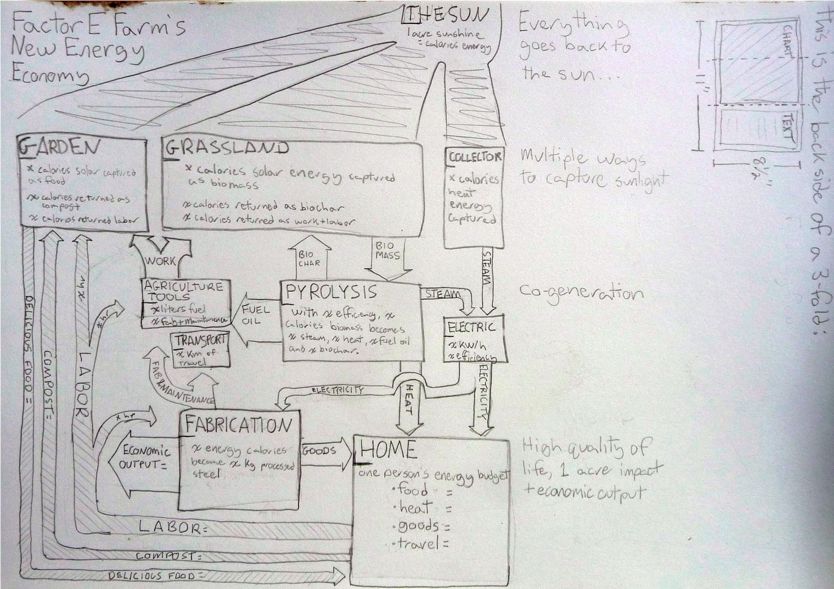Factor e Farm Energy Cycle: Difference between revisions
| Line 27: | Line 27: | ||
** -> gasoline has an energy content of 120 MJ/gallon | ** -> gasoline has an energy content of 120 MJ/gallon | ||
** '''-> The sun showers us with the equivalent of 270,000 gallons of fuel per acre per year at Factor e Farm, Missouri, central USA!!!''' | ** '''-> The sun showers us with the equivalent of 270,000 gallons of fuel per acre per year at Factor e Farm, Missouri, central USA!!!''' | ||
=Significance= | |||
The significance of the above figure fo 270,000 gallons of gasoline-equivalent solar ray energy coming '''PER ACRE PER YEAR''' is a great starting point for capturing some of that energy either in the form of solar concentrator thermal electric power or in the form of chemical energy such as grass. | |||
=Direct Solar Power= | |||
Solar thermal conversion to electricity can happen with overall efficiencies of 10% without any major technological feats. Thus, we can capture the equivalent of 27,000 gallons of fuel equivalent per acre, if overall solar to electric conversion is 10%. In practice, this number will be 1/2 of that because of a 50% fill factor of solar collectors in a given area, or at least 10,000 gallons. That is immense, and it certainly is a baseline case for pursuing solar thermal electric power. | |||
If we go to grass crop, we take 10% efficiency of energy capture by plants, 10% efficiency of transformation of the captured energy into biomass, 50% efficiency of seasonal growth (considering winter and other inhospitable times when growth stops) and a 50% fuel yield from biomass converted to liquid fuels, such as pyrolysis oil. This 1/400 overall efficiency indicates a yield of 270,000 gallons reduced to 680 gallons per acre. This matches proven sustainable grass yields of 4000 dry lbs/acre - or about 200 gallons of liquid fuel equivalent, where 1 gallon is about 10 lbs and fuel yields of pyrolysis oil are 50%. The factor of 3 or so difference is a reasonable difference, provided that we have used absolutely generalized concepts in the calculation based on the solar 32 terajoules. | |||
Welcome to Factor 32 T Farm. | |||
Revision as of 20:04, 24 March 2009
Introduction
We need to start by defining our terms. We use:
- 1 calorie = 4.2 Joules
- This is the amount of heat energy needed to raise the temperature of one gram of water by 1 degree Celsius
- 1 Calorie = 4200 J
- calorie with capital C is the heat energy needed to raise the temperature of one kilogram of water by 1 degree Celsius
- calory = 4.2 Joules
- This is used for food energy values.
Furthermore:
- One kilowatt hour (1 kWhr) is 3,600,000 joules or 3.6 megajoules; look up Joule on wikipedia; this is also equivalent to 1 Whr = 3.6 kilojoules = 15 kilocalories = 15 kcal
- Solar energy coming to the earth is about 1 kW per square meter
- 1 acre is about 4000 square meters
- Thus, 1 acre intercepts a power of 4 megawatts
- Given a single day has 6 hours of direct sunlight on average over the year, we have a total of approximately 24 megawatt hours per day coming to each acre of Factor e Farm, or a total of about 9 GW hours per year
- Multiply 1 Whr = 15 kcal by 9G (billion) to obtain this yearly amount of calories:
- 15 kcal * 9 billion = 135 Teracalories = 32 TJ
- Compare to 1 gallon of gasoline equivalent
- Consider that 1 BTU = 1055 joules
- Gasoline has an energy content of about 114000 BTU per gallon
- -> gasoline has an energy content of 120 MJ/gallon
- -> The sun showers us with the equivalent of 270,000 gallons of fuel per acre per year at Factor e Farm, Missouri, central USA!!!
Significance
The significance of the above figure fo 270,000 gallons of gasoline-equivalent solar ray energy coming PER ACRE PER YEAR is a great starting point for capturing some of that energy either in the form of solar concentrator thermal electric power or in the form of chemical energy such as grass.
Direct Solar Power
Solar thermal conversion to electricity can happen with overall efficiencies of 10% without any major technological feats. Thus, we can capture the equivalent of 27,000 gallons of fuel equivalent per acre, if overall solar to electric conversion is 10%. In practice, this number will be 1/2 of that because of a 50% fill factor of solar collectors in a given area, or at least 10,000 gallons. That is immense, and it certainly is a baseline case for pursuing solar thermal electric power.
If we go to grass crop, we take 10% efficiency of energy capture by plants, 10% efficiency of transformation of the captured energy into biomass, 50% efficiency of seasonal growth (considering winter and other inhospitable times when growth stops) and a 50% fuel yield from biomass converted to liquid fuels, such as pyrolysis oil. This 1/400 overall efficiency indicates a yield of 270,000 gallons reduced to 680 gallons per acre. This matches proven sustainable grass yields of 4000 dry lbs/acre - or about 200 gallons of liquid fuel equivalent, where 1 gallon is about 10 lbs and fuel yields of pyrolysis oil are 50%. The factor of 3 or so difference is a reasonable difference, provided that we have used absolutely generalized concepts in the calculation based on the solar 32 terajoules.
Welcome to Factor 32 T Farm.
